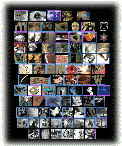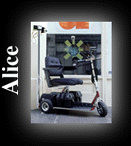Nina Sobell and Emily Hartzell: Collaborators in Art with Technology
Abstract from a chapter we wrote for the book on Women, Art, and Technology edited by Judy Malloy for Leonardo, MIT Press (1998):
We have experimented with the Web to discover its potential for creative, collaborative expression, and to explore and sculpt the boundaries between physical space and cyberspace. Our work has grown directly out of Nina's interactive video installations of the early 1970's, in which she used the medium to sculpt space and time, and to create bridges for shared human experience. Our inspiration, in ParkBench, has been to address the physical disconnectedness of the information age by creating a safe place to congregate in cyberspace. Our work has inspired the development of new technologies, including a wireless telerobotic video camera for streaming video to the Web from remote locations.
Complete text
 |
What's ParkBench?
In 1993, Sobell conceived of ParkBench, a network of kiosks, which, through videoconferencing, internet access, and a collaborative drawing space, would enable people in diverse neighborhoods to access the internet, talk to and see one another, and communicate collaboratively and creatively. Sobell and her collaborator Emily Hartzell were invited to be artists in residence at New York University's Center for Advanced Technology in order to develop ParkBench. Since this was before the Web's emergence, we used Director to design the ParkBench interface, which guides users to community and cultural information, and was the first such graphical interface for New York. Later, in 1994, after the Mosaic browser introduced a graphical interface for the internet, we adapted our interface, making it the first of its kind on the World Wide Web.
|

|
ArTisTheater Performance Archive
At NYU CAT, in 1994, we used one of the Web's
first remotely-controlled cameras to transform our studio
into a time-based public Web
installation in order to research the nature of Web video as a
medium.
The Web gave
visitors 24-hour real-time access, through the eye of the camera, to
watch us work, so at times our
actions
were heightened by our awareness of unseen Web visitors. At other
times we felt ourselves dissolved
in the ubiquitous surveillance which now erases the boundaries between
private and public.
In 1994 we launched the Web's first live
performance series, ArTisTheater, whose archive of
non-narrative, improvisational, dadaesque works now contains over 80
performances (including works by
guest artists.) The performances reflect the evolvement of
technology from the first telerobotic B/W pinhole camera to
experimental color, true color and sound as they move from the first
performance, in the bottom right hand corner to the most recent, in
the top row.
|

|
VirtuAlice
We created VirtuAlice in 1995, with engineers at New York University Center for Advanced Technology, for the CODE exhibition at Ricco Maresca Gallery in New York. Alice is a wireless, mobile, content-collection vehicle for the Web. Alice's eye (a telerobotic camera), uploads video stills to the Web, where online visitors, and those watching at the gallery's front window, control the camera's direction.
VirtuAlice consists of Alice's wheeled throne, a monitor inside the gallery displaying the activity outside, superimposed on the inside, and a monitor in the gallery's front window surrounded by touch pads. A tiny closed-circuit surveillance camera was sewn onto a Queen of hearts playing card mounted at the 12 o'clock position of the surrounding touch pads, focused on the front window participant and superimposing their image over the gallery show inside, making them a part of it. Visitors drive the throne around the gallery, and the direction of the tele-robotic camera mounted on the throne is controlled by participants over the Web, or by touching the pads surrounding the monitor in the front window. A monitor on the throne's handlebars shows the driver the direction of the Web, or front window visitor's interest; the throne's driver acts as chauffeur for the Web or front window visitor. A rear view mirror on the handle bars can reflect the face of the chauffeur by aiming the telerobotic eye into it.
Her memories, the archive of what she's seen in a day, represent a subjectivity negotiated by participants in three spaces: interior, exterior, and webterior/webspace.
VirtuAlice is a vehicle for a shared experience, whereby participants collaborate in transferring that experience into meaning, into history. By appropriating surveillance technology and interweaving surveillance streams, she raises questions about subjectivity and control. VirtuAlice is an expression of the process, which is the world we live in--physically out-of-control--yet remotely controlled.
|

|
In February 1995, Hartzell conceived and designed Barterama,
which was intended to take advantage of the Web's facilitation of
many-to-many communications to enable people to connect with others whose
needs were complementary with their own. Having studied successful barter
networks, it was clear to her that the necessary conditions--a large,
diverse population, and an efficient communication system--were met
ideally by the Web. Barterama, too, was the first Website of its kind.
|
Anarchy, Art, and the Web
Writes L. Susan Brown, a contemporary anarchist, "Meaning must always
be recreated by human
individuals living in history. . . Human individuals create a world
which simultaneously becomes a
context for their own existence."
Access to a global, self-selecting Web audience, independent of the
institutional mandates of
galleries and museums, has enlarged our context-world. Unregulated
and global, our Web studio is a hybrid public/private space where we
define the nature of our work, in dialog with our audience.
This dialog completes the meaning of the work.
We delivered a paper by this title at Los Angeles Museum of Contemporary Art in 1997. Complete text
The Artists
Nina Sobell is a pioneer video artist whose improvisational time-based sound and image Web performances are embedded
with her drawing, sculpture and video background. She is inspired by the collaborative process that evolves from crossing
the lines of music, art and technology, and opening up these channels interactively to the public, initially through interactive
video installations, and more recently on the Web. Sobell is primarily interested in non-narrative work that leaves open the
possibility for multiple interpretations. Her collaborations and installations as a core member of ParkBench stem from her
efforts to demystify technology by assisting in the implementation of ParkBench Public Access Web kiosks run by inner city
youth. Sobell envisions ParkBench as a way to promote multicultural, transmedia dialogue and as a safe place to congregate
in cyberspace. She is the recipient of numerous awards, including grants from the NEA and NYSCA for her pioneering
video performance art. She received a BFA sculpture and printmaking from
Tyler School of Art, Temple University, and an MFA in sculpture from
Cornell University. Her sculptures, installations, and video art have
been shown throughout the World. [more. . .]
[portfolio. . .]
Emily Hartzell is a multimedia artist, whose work
includes photography, artists books, video, multimedia, and
drawings. She was curator of the multimedia shows At
the Intersection of Cinema and Books and Woman on Earth at
Granary Books Gallery in 1992. In 1994 she began collaborating with
Sobell on ParkBench. She works as media-artist-in-residence
in a number of New York City schools, initiating projects in web design,
multimedia animation, and video with elementary and middle school
students. She graduated magna cum laude in Visual and Environmental
Studies from Harvard University and received her MFA in Computer Art from
the School of Visual Arts. Her work has been exhibited widely.
Sonya Allin is a student of Computer Science at Columbia University, a
video afficionado, a techie for http://www.gURL.com/ and a dabbler.
Study and research have touched on intelligent systems, specifically
natural language processing techniques. Study and ongoing play pertains
to animation, vision, the brain.
Jesse Gilbert is a composer, multi-instrumentalist, musicologist, and
digital audio specialist. Gilbert's interests have carried him into
various
realms of the digital art/music world - from networking to improvisational
saxophone performance, 3D modeling and animation to sound synthesis.
He has performed in the New York City and San Francisco areas, and is
currently at work on a series of site specific compositions and ongoing
collaborative work with Parkbench at the NYU Center for Advanced
Technology and Power and Light, NYC. Gilbert graduated with honors
from Wesleyan University and
received the Pokora prize
in composition after studying with such luminaries as Alvin Lucier,
Anthony Braxton, Ron
Kuivila, and Abraham Adzenyah. He was awarded a Watson Fellowship
for a yearlong independent study of the relationship of oral tradition to
music pedagogy in a wide range of regions of Ghana, West Africa. Gilbert
is a researcher at EDC/Center for
Children and
Technology, a non-profit research and development organization that
addresses approaches
to technology and educational reform. He oversaw the functioning of the
sound component of PORT, and works
with collaborators
Helen Thorington and Marek Walczak on the ADRIFT project.
|
 Winner of Art & Science Collaborations' Digital99 Award
Winner of Art & Science Collaborations' Digital99 Award 1999 Webby Award Nominee
1999 Webby Award Nominee
 Pick of the Week Jan '99
Pick of the Week Jan '99





